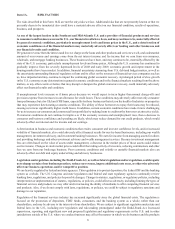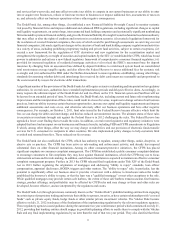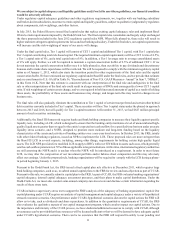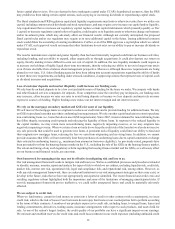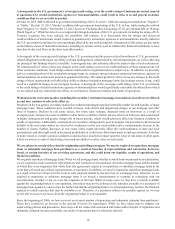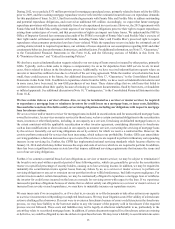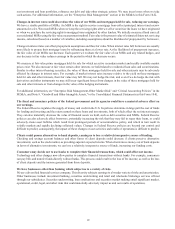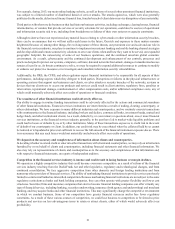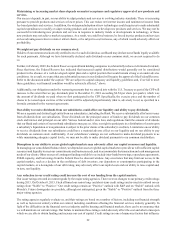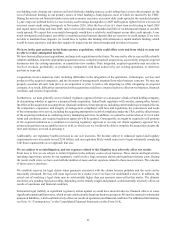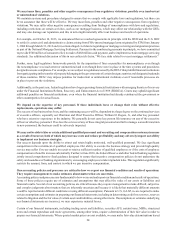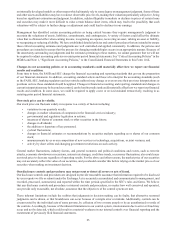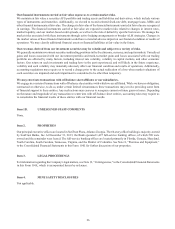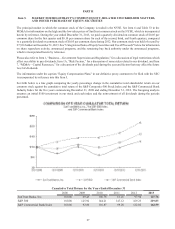SunTrust 2013 Annual Report Download - page 34
Download and view the complete annual report
Please find page 34 of the 2013 SunTrust annual report below. You can navigate through the pages in the report by either clicking on the pages listed below, or by using the keyword search tool below to find specific information within the annual report.18
Changes in market interest rates or capital markets could adversely affect our revenue and expense, the value of assets
and obligations, and the availability and cost of capital and liquidity.
Market risk refers to potential losses arising from changes in interest rates, foreign exchange rates, equity prices, commodity
prices, and other relevant market rates or prices. Interest rate risk, defined as the exposure of net interest income and MVE
to adverse movements in interest rates, is our primary market risk, and mainly arises from the structure of the balance sheet,
which includes all loans. Variable rate loans, prior to any hedging related actions, are approximately 56% of total loans and
approximately 43% of total loans after giving consideration to hedging related actions. We are also exposed to market risk in
our trading instruments, AFS investment portfolio, MSRs, loan warehouse and pipeline, and debt and brokered deposits carried
at fair value. ALCO meets regularly and is responsible for reviewing our open positions and establishing policies to monitor
and limit exposure to market risk. The policies established by ALCO are reviewed and approved by our Board.
Given our business mix, and the fact that most of the assets and liabilities are financial in nature, we tend to be sensitive to
market interest rate movements and the performance of the financial markets. In addition to the impact of the general economy,
changes in interest rates or in valuations in the debt or equity markets could directly impact us in one or more of the following
ways:
• The yield on earning assets and rates paid on interest-bearing liabilities may change in disproportionate ways;
• The value of certain balance sheet and off-balance sheet financial instruments or the value of equity investments that we
hold could decline;
• The value of our pension plan assets could decline, thereby potentially requiring us to further fund the plan; or
• To the extent we access capital markets to raise funds to support our business, such changes could affect the cost of such
funds or the ability to raise such funds.
Our net interest income is the interest we earn on loans, debt securities and other assets we hold less the interest we pay on
our deposits, long-term and short-term debt, and other liabilities. Net interest income is a function of both our net interest
margin-the difference between the yield we earn on our assets and the interest rate we pay for deposits and our other sources
of funding-and the amount of earning assets we hold. Changes in either our net interest margin or the amount of earning assets
we hold could affect our net interest income and our earnings. Changes in interest rates can affect our net interest margin.
Although the yield we earn on our assets and our funding costs tend to move in the same direction in response to changes in
interest rates, one can rise or fall faster than the other, causing our net interest margin to expand or contract. Our liabilities
tend to be shorter in duration than our assets, so they may adjust faster in response to changes in interest rates. When interest
rates rise, our funding costs may rise faster than the yield we earn on our assets, causing our net interest margin to contract
until the asset yield catches up.
The amount and type of earning assets we hold can affect our yield and net interest margin. We hold earning assets in the form
of loans and investment securities, among other assets. As noted above, if current economic conditions persist, we may continue
to see lower demand for loans by creditworthy customers, reducing our yield. In addition, we may invest in lower yielding
investment securities for a variety of reasons.
Changes in the slope of the “yield curve,” or the spread between short-term and long-term interest rates, could also reduce
our net interest margin. Normally, the yield curve is upward sloping, meaning short-term rates are lower than long-term rates.
Because our liabilities tend to be shorter in duration than our assets, when the yield curve flattens or even inverts, our net
interest margin could decrease as our cost of funds increases relative to the yield we can earn on our assets. The interest we
earn on our assets and our costs to fund those assets may be affected by changes in market interest rates, changes in the slope
of the yield curve, and our cost of funding. This could lower our net interest margin and our net interest income. We discuss
these topics in greater detail under the caption “Enterprise Risk Management” in the MD&A in this Form 10-K.
During the third quarter of 2013, the Federal Reserve reaffirmed that a highly accommodative monetary policy will remain
in effect for a considerable time after its asset purchase program ends and the economic recovery strengthens. Accordingly,
the Federal Reserve conveyed that it anticipates maintaining key interest rates at exceptionally low levels, at least as long as
the unemployment rate remains above 6.5% and its long-term inflation goals are not met. A persistent low interest rate
environment likely will adversely affect the interest income we earn on loans and investments.
We assess our interest rate risk by estimating the effect on our earnings under various scenarios that differ based on assumptions
about the direction, magnitude and speed of interest rate changes and the slope of the yield curve. We hedge some of that
interest rate risk with interest rate derivatives.
We may not hedge all of our interest rate risk. There is always the risk that changes in interest rates could reduce our net
interest income and our earnings in material amounts, especially if actual conditions turn out to be materially different than
what we assumed. For example, if interest rates rise or fall faster than we assumed or the slope of the yield curve changes,
we may incur significant losses on debt securities we hold as investments. To reduce our interest rate risk, we may rebalance


